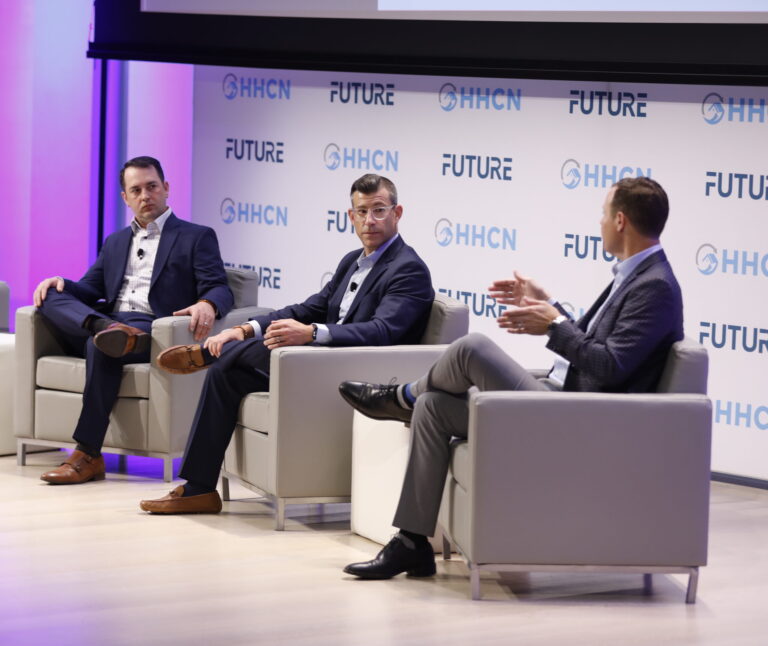
Organizations far and wide are leveraging their internal innovation and home-based care to reduce readmissions and other avoidable hospitalizations.
Three of those organizations — all unique in their own way — were on hand at Home Health Care News’ FUTURE event to discuss what makes their companies innovative and what disruptions they are making in the home.
The Michigan-based U.S. Medical Management (USMM) is a home-based management services organization that serves 35,000 patients per month in 35 markets across 11 states.
Outside of its primary care assets, its home health asset is Pinnacle Home Health, and it operates hospice through Grace and Comfort.
It also has mobile lab services, mobile radiology capabilities and an in-home assessment business.
“What our patients most appreciate about that is that we’re not further contributing to displacement when we’re able to bring them into our orbit,” James Lydiard, chief strategy officer at USMM, said at FUTURE. “So long as we are able to contract with a health plan or the government across all of our business units, they really get the full continuum and we can really bridge all their necessary transitions of care.”

On its end, the health system Kaiser Permanente has made significant progress on its at-home care capabilities since the onset of COVID-19.
Prior to the pandemic, Kaiser was able to identify the technological advances and innovations that were coming to home-based care and capitalized on regulations once COVID-19 forced more care into the home.
“This is not a house call system,” Joel Womack, regional chief of hospital medicine for Kaiser’s
Northwest Permanente, said on the same panel. “Our physicians are part of a care hub that is linked to the patient’s home via video visits – where we provide care with in-home care providers for multiple disciplines – with a doctor directing medical care from a virtual hub.”
While many in the space are moving towards this model, Womack said Kaiser has been at the forefront of this type of care for several years now.
Finally, Geisinger Health is a Pennsylvania-based health system that does a little bit of everything. That’s one of the reasons why Anthony Wylie, the senior medical director at Geisinger at Home, joined the team in the first place.
“What drew me to Geisinger at Home was this concept of taking the top 3% of cost and utilization in a Medicare Advantage population and combining a number of services,” Wylie said. “Taking that spectrum of services that were described today — alongside close partnerships with home health agencies — and providing it to a really high risk, high cost, high utilizing population.”
Geisinger at Home has enrolled about 11,000 patients across 17 counties in the last four years.
Innovation in the home
Kaiser Permanente makes sure that its home-based care services are not provided on an island or in a silo.

Communication in its home-based care programs is key, Womack said.
“You have home care providers, for instance, that are nimble and able to give direct feedback when they are in the home,” Womack said. “Whether it be wound care, physical therapy, etcetera, we have closed loop communication with them and we really depend on them for delivering this acute care in the home.”
Due to its innovative approach, Womack said patients are experiencing a much smoother transition in care.
Readmission rates back for Kaiser sit at about 9%, much lower than the national average of 13%. Similarly, patients receiving congestive heart failure (CHF) care at Kaiser Permanente see about a 13% to 15% readmission rate at 30 days.
Historically, the national average for CHF care patients is 20% to 25%, Womack said.
For Geisinger at Home, the innovation lies within the interdisciplinary care team.
Geisinger has delivered a 30% reduction in admissions for its MA partners’ members and a $440 drop in costs for those members on a monthly basis.

“We have nurse case managers that not only do the typical care coordinator role, but also provide acute interventions alongside mobile paramedics,” Wylie said. “We have physician-led groups of advanced practitioners, registered dieticians, nutritionists, etcetera. So that whole team’s been able to allow us, I think, to provide some pretty good outcomes.”
From a cost of care perspective, USMM has yet to see where dollars are wasted in home-based care. USMM is betting on home-based care because it believes that almost all spending in the home is an investment, Lydiard said.
“We try to promote more [home-based care investment] because we’re seeing the rich outcomes on the back end,” Lydiard said.
USMM is also finding success in being flexible with how it deploys its resources and assets.
“In markets where we have downside risk arrangements that are obviously bred through our primary care engine, I may not need that home health agency to jam a bunch of patient census in other payer types,” Lydiard said. “The greater good of the organization may say, ‘I can actually do better if, in a pinch, I’m able to send a home health agency out for an appropriate, necessary visit,’ but I can’t have that home health team off doing other business that doesn’t involve downside risk.”
USMM is actually looking at its home health, hospice, radiology and other assets not as necessary revenue-generating entities.
Instead, those assets are investments that drive good outcomes and are a part of a package deal that is available for its payer partners.
“I certainly see the most payment innovation right now happening within primary care,” Lydiard said. “If this is the way that the temperature is right now, let’s make sure that we’re putting that solution first and foremost. It doesn’t mean that we’re removing home health and hospice from the deal, it just means that they’re playing a different role as far as a role player goes in the current state of affairs.”